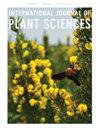北美蓟科植物的多样性和生物地理学:快速全大陆辐射的驱动因素
IF 1.5
3区 生物学
Q3 PLANT SCIENCES
引用次数: 2
摘要
研究的前提。蓟(“蓟”)是原产于北美的菊科(菊科)Carduoideae亚科中物种最多的属,具有快速的地方性辐射。蜂鸟授粉在菊科中是罕见的,但在北美,大约10%的茜草适应了这种授粉综合症。虽然Cirsium是整个大陆进化辐射的一个例子,但促成这种显著多样化的生物和非生物因素从未被研究过。方法。利用MYbaits Compositae 1061 1kv1试剂盒对代表其在北美分布的64个卷叶菊分类群进行了测序。这些结果被用来推断一个时间校准的系统发育,以估计分化时间和多样化率。利用biogeobars对8个生物地理区和10个生境进行了祖先区重建。采用模型拟合方法检验(1)不同环境变量是否与多样化相关,(2)传粉者类型是否与环境差异相关,(3)传粉者类型是否与多样化相关。系统发育最小二乘模型对多样化率测试是否环境变量,传粉者类型,或形态性状影响多样化。关键的结果。北美的进化大约起源于2000万年前,大部分的多样化发生在更新世冰期开始时几乎同时发生的三次爆发中。虽然大多数性状显示出系统发育信号,但没有显著的形态创新,从而导致了卷叶菊的整体多样化。降水和半干旱是多样化的主要催化剂。与昆虫授粉相比,蜂鸟授粉的多样化率几乎显著低于昆虫授粉。结论。生态位保守性和冰期-间冰期旋回的综合作用在形成当前的分布格局中发挥了作用,特别是在科罗拉多高原的高山系统和峡谷中。虽然蜂鸟授粉与Cirsium较低的多样化率有关,但这种综合征的转变可能促进了更新世后破碎景观的扩张。最终,这项研究为快速、全大陆辐射的驱动因素和更新世冰川周期对北美植物区系的影响提供了重要的见解。本文章由计算机程序翻译,如有差异,请以英文原文为准。
Diversification and Biogeography of North American Thistles (Cirsium: Carduoideae: Compositae): Drivers of a Rapid Continent-Wide Radiation
Premise of research. Cirsium (“thistles”), the most speciose genus in the Compositae (Asteraceae) subfamily Carduoideae native to North America, comprises a rapid endemic radiation. Hummingbird pollination is rare in Compositae, but approximately 10% of all Cirsium in North America are adapted to this pollination syndrome. Although Cirsium is an example of a continent-wide evolutionary radiation, the biotic and abiotic factors contributing to this remarkable diversification have never been studied. Methodology. Sixty-four taxa of Cirsium representing its distribution in North America were sequenced using the MYbaits Compositae 1061 1kv1 kit. These results were used to infer a time-calibrated phylogeny to estimate divergence times and diversification rates. Ancestral area reconstructions for eight biogeographical areas and 10 habitats were performed with BioGeoBEARS. A model-fitting approach was used to test whether (1) different environmental variables were related to diversification, (2) pollinator type was related to differences in environment, and (3) pollinator type was related to diversification. Phylogenetic least squares models against diversification rates were used to test whether environmental variables, pollinator type, or morphological traits influenced diversification. Pivotal results. Cirsium in North America originated approximately 2 mya, with the majority of the diversification occurring in three nearly simultaneous bursts during the onset of the Pleistocene ice age. Although most traits showed evidence of phylogenetic signal, there were no significant morphological innovations that contributed to overall diversification in Cirsium. Precipitation and semiaridity were the main catalysts for diversification. Hummingbird pollination was associated with near-significant lower rates of diversification than insect pollination. Conclusions. The integrated effects of niche conservatism and glacial-interglacial cycles played a role in shaping current distributional patterns, particularly in alpine mountain systems and canyons of the Colorado Plateau. Although hummingbird pollination was associated with lower rates of diversification in Cirsium, the switch to this syndrome may have facilitated expansion across post-Pleistocene fragmented landscapes. Ultimately, this study offers important insights into the drivers of a rapid, continent-wide radiation and the impact of Pleistocene glaciation cycles on the flora of North America.
求助全文
通过发布文献求助,成功后即可免费获取论文全文。
去求助
来源期刊
CiteScore
4.50
自引率
4.30%
发文量
65
审稿时长
6-12 weeks
期刊介绍:
The International Journal of Plant Sciences has a distinguished history of publishing research in the plant sciences since 1875. IJPS presents high quality, original, peer-reviewed research from laboratories around the world in all areas of the plant sciences. Topics covered range from genetics and genomics, developmental and cell biology, biochemistry and physiology, to morphology and anatomy, systematics, evolution, paleobotany, plant-microbe interactions, and ecology. IJPS does NOT publish papers on agriculture or crop improvement. In addition to full-length research papers, IJPS publishes review articles, including the open access Coulter Reviews, rapid communications, and perspectives. IJPS welcomes contributions that present evaluations and new perspectives on areas of current interest in plant biology. IJPS publishes nine issues per year and regularly features special issues on topics of particular interest, including new and exciting research originally presented at major botanical conferences.

 求助内容:
求助内容: 应助结果提醒方式:
应助结果提醒方式:


